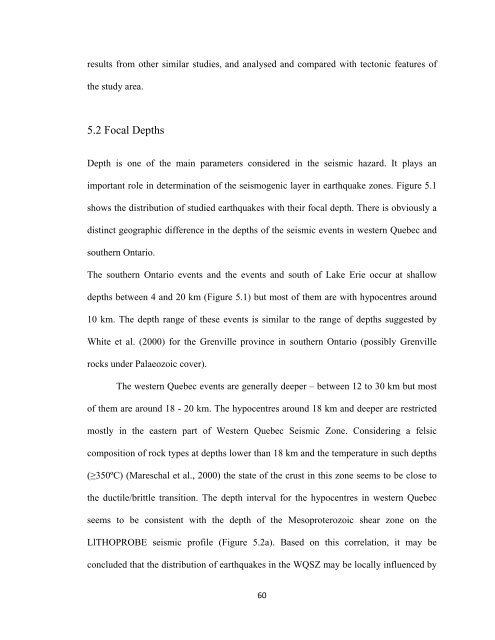western quebec and southern ontario - Department of Geology
western quebec and southern ontario - Department of Geology
western quebec and southern ontario - Department of Geology
You also want an ePaper? Increase the reach of your titles
YUMPU automatically turns print PDFs into web optimized ePapers that Google loves.
esults from other similar studies, <strong>and</strong> analysed <strong>and</strong> compared with tectonic features <strong>of</strong>the study area.5.2 Focal DepthsDepth is one <strong>of</strong> the main parameters considered in the seismic hazard. It plays animportant role in determination <strong>of</strong> the seismogenic layer in earthquake zones. Figure 5.1shows the distribution <strong>of</strong> studied earthquakes with their focal depth. There is obviously adistinct geographic difference in the depths <strong>of</strong> the seismic events in <strong>western</strong> Quebec <strong>and</strong><strong>southern</strong> Ontario.The <strong>southern</strong> Ontario events <strong>and</strong> the events <strong>and</strong> south <strong>of</strong> Lake Erie occur at shallowdepths between 4 <strong>and</strong> 20 km (Figure 5.1) but most <strong>of</strong> them are with hypocentres around10 km. The depth range <strong>of</strong> these events is similar to the range <strong>of</strong> depths suggested byWhite et al. (2000) for the Grenville province in <strong>southern</strong> Ontario (possibly Grenvillerocks under Palaeozoic cover).The <strong>western</strong> Quebec events are generally deeper – between 12 to 30 km but most<strong>of</strong> them are around 18 - 20 km. The hypocentres around 18 km <strong>and</strong> deeper are restrictedmostly in the eastern part <strong>of</strong> Western Quebec Seismic Zone. Considering a felsiccomposition <strong>of</strong> rock types at depths lower than 18 km <strong>and</strong> the temperature in such depths(≥350ºC) (Mareschal et al., 2000) the state <strong>of</strong> the crust in this zone seems to be close tothe ductile/brittle transition. The depth interval for the hypocentres in <strong>western</strong> Quebecseems to be consistent with the depth <strong>of</strong> the Mesoproterozoic shear zone on theLlTHOPROBE seismic pr<strong>of</strong>ile (Figure 5.2a). Based on this correlation, it may beconcluded that the distribution <strong>of</strong> earthquakes in the WQSZ may be locally influenced by60
















